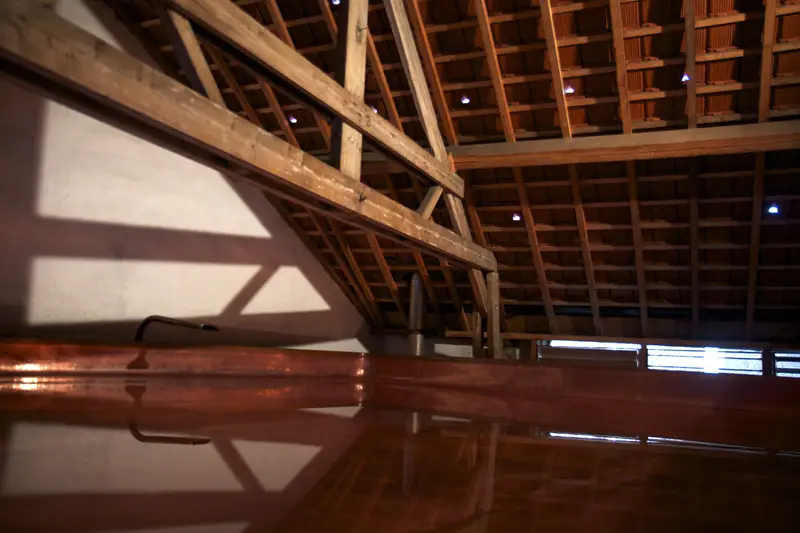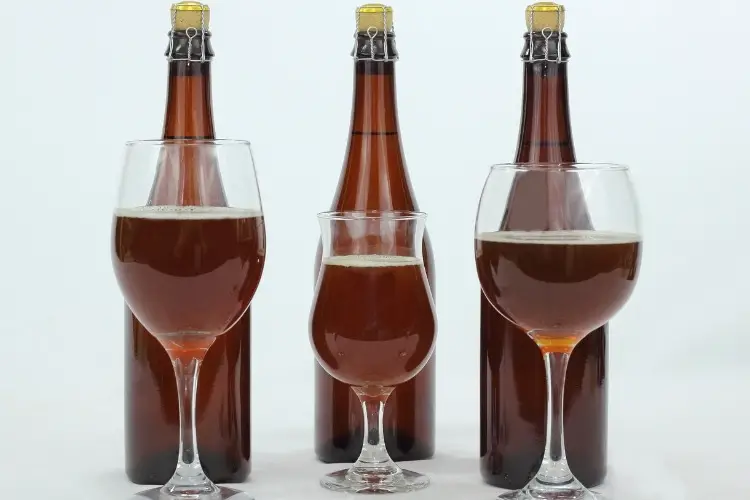Lambic beer is the penultimate grail of beer brewing, loved and reviled equally among even the greatest brewers. It is among the hardest beers to emulate in a home brewery. Undaunted, move ahead with your plan, be fearless, and therein lies the opportunity for greatness.
Lambic beer is the hardest beer to emulate at home, yet its essence is attainable. Employing Lambic process techniques, a mix of pure and wild yeast strains, and long aging, will produce sour beer of depth and sublimity.
Prefer Belgian beer, sour and enigmatic? Lambic beers, Old Browns, Flemish Reds? As a beer guy and brewer of many years I often think about them with relish and longing, like the salad days of a youthful exuberance.
Making Lambic at Home: Assembling the Ingredients
I say with all honesty, this is up to you.
My most successful, personal favorite creation was called Flanders Abbey Ale, a pale Belgian ale wherein I formulated no recipe until not only brew day but until each individual step of the brewing process itself: including but not limited to water temp, malt content, mash temp, sparge temp, hop choice, IBU’s, hop staging, and pitching temperature.
Spontaneity was the theme of the day.
I’d been brewing several long years at that point, the point being however, put your heart into it.
The brewer himself, not others, is the standard to which this great beer shall be held.
Authentic Malt and Hops
Lambic beer can traditionally be 50% wheat – some unmalted – mixed with barley malt.
The unmalted wheat will be cooked first then added into the mash, and step-mashed (run through a series of varied temperatures to activate different enzymes).
This is an exacting process and proprietary to the brewers.
German lager brewers also use step-mashing, and Charlie Papazian has written about it at length.
This is unnecessary for you.
American’s prefer highly modified (actively enzymatic) 2-row barley malt, so step mashing is usually eschewed by even the best among us.
For Lambic brewers, hops in a sense are an afterthought and are used sparingly and always stale and oxidized.
They are valued for their preservative qualities more than their actual flavor or bitterness.
Their cheesy (Isovaleric Acid) essence is quite distinct during fermentation.
I recall tasting fermenting Lambic in the Brouwerij 3 Fonteinen, Beersel, Belgium, many years back. I had the pleasure of some legendary Belgian brewers as company that day. Old Gouda cheese was the defining nose of this extraordinarily young fermenting beer.
Lambic Yeast
Gentlemen and gentleladies, this is where the rubber meets the road, the men are separated from the boys…yeast defines Lambic beer and defies all other styles.
Lambic beer is spontaneously fermented: meaning the yeast literally falls out of the sky.
It can live in trees, plants, fruit, soil, terra cotta tiles, stone and rough cut timber of old attic spaces. That is how true Lambic brewers pitch.
Lambic Is a Blend of New and Old Beer
Yes. A blend of new and old beer.
First, choose a malty, very low hopped beer from the cellar: Belgian ale, White Beer, American gold, Helles, Amber Ale.
When bottling, rack at least 2-3 gallons off into 1-gallon jugs, or a 3-gallon carboy; glass only.
Belgian beer is recommended as it ages well, for months and will not autolyze or turn on you like some standard ale yeast.
This beer has been racked at least twice, let us assume it is late fall, winter, or early spring. Cellar it for 4-6 months.
Your next brew, again will be a low hopped beer, brewed with Belgian yeast. I used lager beer and blended with white beer in one of my two Lambic style batches.
Again, hop low. 9 – 12 IBU’s at the max, not HBUs! Refer to this article for IBU calculation and precise bitterness calculations as practiced by the pros.
For hops, I recommend Styrian Goldings, Hersbrucker (horsef#ckers, as Ben the Beer Boy and I used to irreverently shout), Saaz or some other extremely low Alpha European hop.
That said, there are some amazing new strains of low Alpha aroma hops coming out of Washington and Oregon now, Citra and HBC 692 (yeah, not kidding).
How to Blend Old and New Beer?
Brew the beer as usual.
Assume the first stage was brewed in the fall, and the second one in late winter.
Ferment for 2 weeks and as it’s racked into secondary, have your 2.5 gallons of old beer waiting in a carboy.
Rack half of the new batch on top.
Adding Fruit
You may or may not want to add fruit, in which case you will have a Gueuze beer; unfruited Lambic beer.
A 6.5-gallon carboy is useful here as extra head space will likely be needed. Choose a fruit you like and go to town.
My brother brewmaster Sam would soak his fruit in a hot kettle during cooldown. Excellent technique. I chose a different way.
Rinse the fruit with cold water and rack all the beer right on top. Do not pasteurize or cook first. If the fruit is fresh-picked all the better, as it will have live yeast on it. In this case, do not even wash it…or do.
Cantillon, (est. 1900) the famed Brussels Lambic brewer puts unwashed fruit in their barrels.
At the French Broad Brewing Co in Asheville, NC, I hadn’t fresh fruit so ordered pure fruit puree from Oregon and dumped it through the top tank port. I can’t recall exactly how much, perhaps 15 gallons for about 12 barrels of beer.
At home, I’d go fresh all the way.
Adding Wild Yeast
And herein lies the rub.
There are already 1 or 2 yeasts in the beer, the new and old beer blended. You added rinsed (or not) fruit so wild yeast is in the mix.
There are now amazing varieties of pitchable wild liquid yeast available, perhaps 6 – 12 varieties, truly encompassing.
Choose one that looks good and pitch it into this Tertiary fermentation.
Wild yeast have a certain amount of Pediococcus and lactobacillus in them, or at least competing with them.
The reason I mention this, is yeast ordinarily needs O2 to grow and work. Not so with wild strains.
You are repitching into an anaerobic environment and in essence deliberately infecting your beer.
There should be moderate to medium/ heavy activity due to the fruit.
Wait 2 months, rack again or package in bottles.
Consider corked champagne bottles (just in case). This yeast can be volatile.
I would use a normal priming technique and then wait.
Lambic Recipe Parameters
Target OG: 1.048 – 1.060
Final Gravity: 1.008 – 1.016
IBUs: 6 – 12, * because of the nature of the blending, the beer may be more bitter than this.
Traditionally, only stale leaf hops would be used, for preservative effect only.
Lambics are usually about 5 – 5.5% alcohol. A home effort might be a little stouter: 6 -7%. This is due to the base beers used for blending and the additional sugar picked up from the fruit.
The Recipe:
|
|
Aging and Accompanying Flavors
The beer has been working about 8 months at this point. You could likely package in regular bottles, but wild yeast is so unpredictable, a corked bottle is better.
Wait at least 4 months more and taste it.
It will resemble beer but have intense bitter yet remarkable flavors, including but not limited to:
- Acetaldehyde will form lactic acid: tart, fruity, dry
- Phenolic: spicy, herbal, medicinal
- Cheesy (Isovaleric Acid): Gouda cheese, goaty, horse blanket, barnyard (my favorites)
In all likelihood, you’ll need to wait another 6 – 12 months. During the second year, the flavors integrate and come together.
Or… it may be too sour and astringent and have to pour it out.
I visited Brasserie de Cantillon last in 2018. They make no secret of the fact they dump 15 – 20% of their beer. As their beer is spontaneously fermented by micro flora in their terroir, the mix is off some days. It’s a crapshoot.

Final Aging
Brewers, home and pro will disagree with me. Let them.
We do not live near Brussels, Belgium. A homebrewer emulates a process.
The yeast is controlled – somewhat. Using instincts, knowledge and an adventurous nature, the brewer embarks on a long journey, destination unknown.
Let us call it the Road Not Taken. It will make all the difference in your brewing life.
Epilogue
One Lambic style (of 2) I brewed at French Broad was a mix between a Märzen OG 1.046, FG ??? (young- still in secondary), AND a Bock beer OG 1.060, FG 1.016 (4 months old).
I added the Blackberry puree and injected a wild yeast strain grown up in a soda keg.
I kegged after 4 months and we started drinking after 1 year. Too young, as impetuous as we were.
1-2 more years went by and there were still about 6 kegs left. We blended them about 40/60 with a Bière blanche, brewed with 100% wheat malt.
That was a fine beer, true to style, delicious and not the end of the story.
Fast forward to 2014 – 2016, one of the last times I visited the States. Sam would occasionally wander down to Asheville on beer runs and drop by the Ol’ French Broad. It was still in the family and they all knew Sam well.
At some point, Sam had got his hands on 3 gallons of the original unblended (with the Blanche) Blackberry Lambic.
At this point the beer was about 10 – 12 years old…and I ain’t tellin’ no stohry, as my Grandma Ruth used to say.
I’m not one to dissect flavor as a sommelier or cicerone might do.
I was more like “Holy F&cking Hell, this is unbelievable.”
It was beer, straight and pure, yet so deep, multi-layered like a choice pastry, port-like with the berries and malt inextricably coupled. The sourness was an attribute, not dominating.
There was not more than 1 – 2 liters left in the keg. A pity. It was likely the finest beer I’d ever tasted. As the brewer, I not others, was the standard to which this preternatural beer was held.

